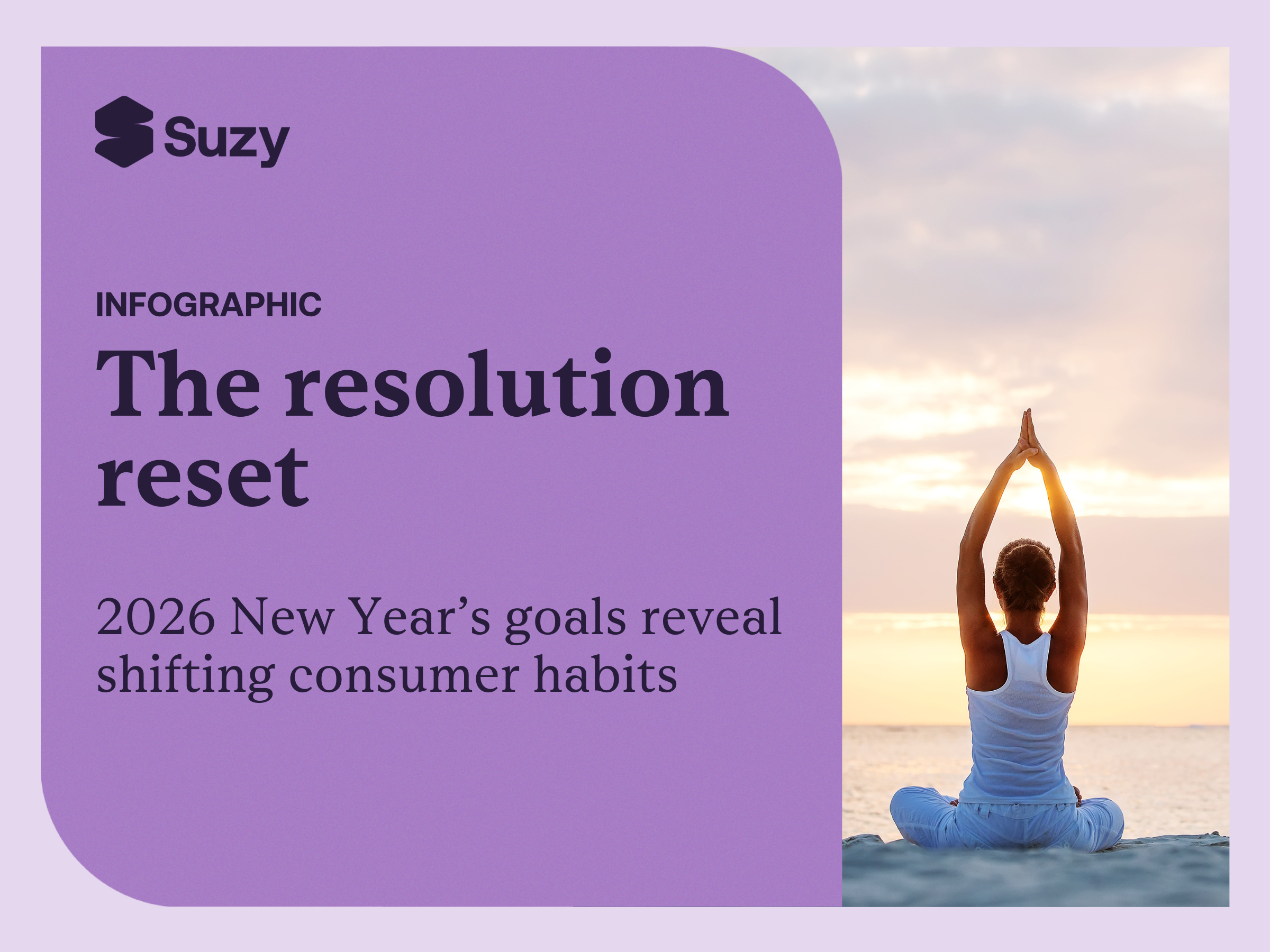By tapping into consumer research platforms like Suzy, running your own qualitative research is a breeze.
For some researchers, considering the role of qualitative data in the broader market research industry is a little like taking a liberal arts course while majoring in a STEM field. When you’re so immersed in weighted statistics and 7-point scales on a daily basis, anything outside of that framework feels daunting or even unnecessary. It might require more interpretation than you’re used to, and figure it’s easier to write it off as irrelevant to your goals.
However, those who don’t account for the complicated, subjective reality of human behavior will have a much harder time anticipating it. That’s why you have to ensure you’re actively digging deeper into the root causes behind all those numbers—and online qualitative research is the best way to do that.
At Suzy, we recognize the indispensable value of integrating qualitative insights with quantitative data. Embracing the complexity of human behavior requires tools that not only gather data but also interpret it in ways that respect its intricacies. Suzy consolidates these tools in one platform, blending the reliability of traditional research methods with the nuanced understanding of qualitative analysis. This approach allows you to seamlessly navigate between quantitative precision and qualitative depth, simplifying your research process without sacrificing the comprehensive insights you need to truly understand your audience.
Let’s take a look at the power of online qualitative market research and how you can do it yourself.
The power of DIY qualitative research
With the ability to conduct research whenever it’s needed, DIY solutions put the consumer where they belong—as the focus of your business. Instead of just a chosen few marketing and product teams having access to consumer insights, DIY market research allows for unconstrained access to consumers for employees across your entire organization. In turn, you can put the consumer at the heart of everything you do—becoming truly consumer-led.
However, there can be a downside to DIY market research if you’re overly limited in your approach. Many DIY tools on the marketplace are only useful for collecting quantitative data—information that can be objectively measured, like numbers or amounts—and not qualitative data, which is more subjective and provides you with a much more nuanced look into what drives your consumers’ thoughts, feelings, and opinions.
This type of imbalance limits the kind of insights you’re able to gather. Quant can’t always answer why consumers approach your products in a certain way, or why they don't like a particular marketing asset. Qual, on the other hand, can uncover the kinds of nuance you need for actionable insights, which is why it’s essential to your success.
Qualitative market research: an example
Quantitative research offers a lot of benefits for market researchers, but often there are hidden insights that come from digging deeper. Here’s an example to illustrate in the form of an anecdote passed around at a research conference a few years back:
A group of researchers working with a popular tortilla chip brand visited various Super Bowl parties to observe how people ate, drank, and engaged with each other during the big game. Over time, the group noticed a pattern emerging. While most of the partygoers seemed to be having a good time, one household member was behaving anxiously.
Finally, one of the researchers asked the angst-ridden hostess to explain what she was feeling at the moment. She explained that she wasn’t able to enjoy the company or the game because she was worried that guests would accidentally drop salsa all over her couch or rug or hardwood floor.
This insight led someone at the chip maker to come up with the idea for a chip that’s curved into a bowl shape for better dip containment. Today, this brand extension is a top five tortilla chip brand in America.
Investing in qualitative insights is worth it
It’s difficult to verify this story is true, but it perfectly illustrates just how important qualitative insights are. There are certain things you’re only going to learn from your consumer if you allow them to express their feelings outside the confines of a multiple-choice question. Asking this hostess to rate her opinion of tortilla chips wouldn’t have led researchers down the right path—after all, the chips weren’t her problem, the risk of mess was!
It’s always a good idea to dig into the WHY behind the WHAT, even if you don’t know where it’ll lead you. The hostess in this story could have been nervous about any number of things; if the researchers hadn’t asked, they might have come to the wrong conclusion and started designing products based on incorrect assumptions. And speaking of which, consumers (like most people!) often don’t know how to articulate their needs without being given a forum to discuss and process them first. Sure, it would be great if the hostess had walked up to a researcher and said, “I’d like a curvy tortilla chip so my guests won’t drop salsa on my furniture,” but how often does that happen in the real world?
How to conduct DIY and online qualitative market research
These days it would be tough to replicate this kind of insight gathering—not just because of the cost and effort involved in going door to door on a busy Sunday evening, but because the recent COVID-19 pandemic has fundamentally changed a lot of the ways we interact with one another on a face-to-face basis. Fortunately, there are ways to tap into the power of qualitative insights online and from the comfort of your workspace. Here’s how:
Ask open-ended questions
When you’re fielding your surveys, it’s tempting to reframe everything in a multiple-choice format so your results are easier to analyze. However, this will limit the kind of results you get back, especially when you’re trying to understand emotions or opinions.
Let’s say you launch this question:
How does this product make you feel?
- Happy.
- Sad.
- Angry.
- None of the above.
If your target consumer is more frustrated with your product than anything else, then what are they going to pick here? Odds are they’ll hit “None of the above,” and you won’t know what they’re feeling, or they’ll go with whatever they think is closest and you won’t get the whole story.
Instead, you could write a question like: “In your own words, please tell us how this product makes you feel. Please be as descriptive as possible, including what specifically about the product makes you feel that way.”
By structuring your question like that, you’ll get a wide range of responses. You may even see some key themes pop out that will tell you much more than our original multiple-choice question.
Video open ends
Video market research offers a whole range of qualitative insights—from expressions to interactions with other participants and beyond. With a video open end, you can get an unmoderated response from consumers. Want to know how they use your product? Ask them to show you. Are they having difficulty with your packaging? Their video open end will give you clarity on what isn’t working. Think of them as your qual, at quant scale!
Facilitate deeper understanding with online focus groups
In-the-moment word choice, tone, facial expressions, or even gestures can often speak volumes more than a block of text. That’s where online focus groups come in.
Much like traditional focus groups, an online focus group brings consumers together for a range of qualitative learnings, including facial expressions, body language, and interactions with one another.
However, in-person focus groups have historically been time-consuming and expensive to set up, requiring travel, facilities, and recruiting participants. Remote focus groups speed that process way up, saving you money and time. You also can moderate your own focus groups, making sure you get the insights you need from the session.
Get personal with in-depth interviews (IDIs)
Hear something interesting from one of your focus group participants? You can invite that person to an in-depth interview (IDI) online to learn more and dig into the granular details. Explore their personal story, thoughts, and feelings in an intimate, online interview setting.
IDIs are best for user testing and sensitive subjects and are a great DIY option when you want to hear from hard-to-schedule participants.
See your product in action with in-home user testing (IHUTs)
You can even take your qualitative video insights beyond the interview. Sending your consumers a product through an IHUT can help you see how they experience your product in their real lives. An IHUT lets you map out the entire customer experience, from unboxing to usage.
Understanding your results
Once you’ve got the results from your qual research—whether in the form of an Excel sheet of open-ended responses or transcripts from your video interviews—there are a couple of ways to analyze the results. You can read through each response or transcript on an individual basis to really get a feel for every single person’s opinion, or you can track common trends in what all the respondents say as a group. Both methods are possible within the Suzy platform.
Plus, with Suzy’s new Qual Analysis tool, you can jumpstart your analysis with AI-powered features. The tool can pull transcripts and project summaries, highlighting the key learnings for you automatically. It also identifies them and can create action plans for your next steps.
When you need to present your findings, you can pull supportive quotes with timestamps for easy reference.
Sharing insights with stakeholders
Now that you have your qualitative data, how can you bring it to life? Video is one of the best ways to communicate your findings—keeping your stakeholders engaged in your content and focused on the insights you’ve discovered. You can give consumers a voice with a DIY video showreel. Combine quant findings and qual video clips to tell your complete story, highlighting key insights and zeroing in on trends.
The Suzy Difference: Integrated quant and qual
Since we launched Suzy Live as an online solution for qual research during the pandemic, marrying online qualitative and quantitative market research has been our bread and butter. Our DIY solutions put qualitative research in your hands—helping you uncover the why behind the trends. Here’s what you can expect from Suzy’s online qualitative offering:
- All your research in one place—both quant and qual. Seamlessly transition between Suzy Live and Suzy Insights for continuous learning.
- Unconstrained access to your target consumer. Retarget your audience and seek intel, showcase ideas, and ship products.
- Live responses delivered fast, ranging from just a few hours for asynchronous input to less than 72 hours for live interviews.
Want to learn more? Book a demo with us today to see how qual works on Suzy’s consumer research platform.
.webp)





.png)

